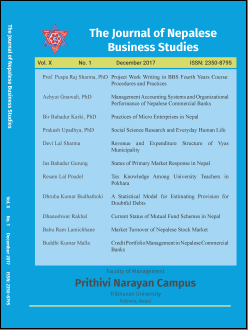Credit Portfolio Management in Nepalese Commercial Banks
DOI:
https://doi.org/10.3126/jnbs.v10i1.19138Keywords:
Banks, Basel, Credit portfolio, Credit risk management, Nepal, Non-performing loanAbstract
Credit portfolio management is a key function for banks (and other financial institutions, including insurers and institutional investors) with large, multifaceted portfolios of credit, often including illiquid loans (Nario, Pfister, Poppensieker & Stegemann, 2016). After global financial crisis of 2007-2008, the credit portfolio management function has become most crucial functions of the bank and financial institutions. The Basel III, third installment of Basel accord was developed after crisis to strengthen bank capital requirements by increasing bank liquidity and decreasing bank leverage that encourages banks to measure credit risk of bank's portfolios. The Basel committee also raises an issue concerning the application of the risk weights used in the capital adequacy framework to determine exposure to risk assets for the purpose of determining large credit exposure (Morris, 2001).
The portfolio management of the Nepalese banking sector has been improved remarkably during last 10 years due to the strict regulation of Nepal Rastra Bank. This journal will try to describe the present credit portfolio management practice of Nepalese commercial banks by using qualitative and quantitative methods. In this study, concentration of banks for credit portfolio management has been studied by analyzing security wise loan, product wise loan and sector wise concentration of loan where the researcher has found assorted outcomes. This research also aims to provide some suggestions to overcome with problems associated with credit portfolio.
The Journal of Nepalese Business Studies Vol. X No. 1 December 2017, Page: 101-109
Downloads
Downloads
Published
How to Cite
Issue
Section
License
This license allows reusers to distribute, remix, adapt, and build upon the material in any medium or format, so long as attribution is given to the creator. The license allows for commercial use.




